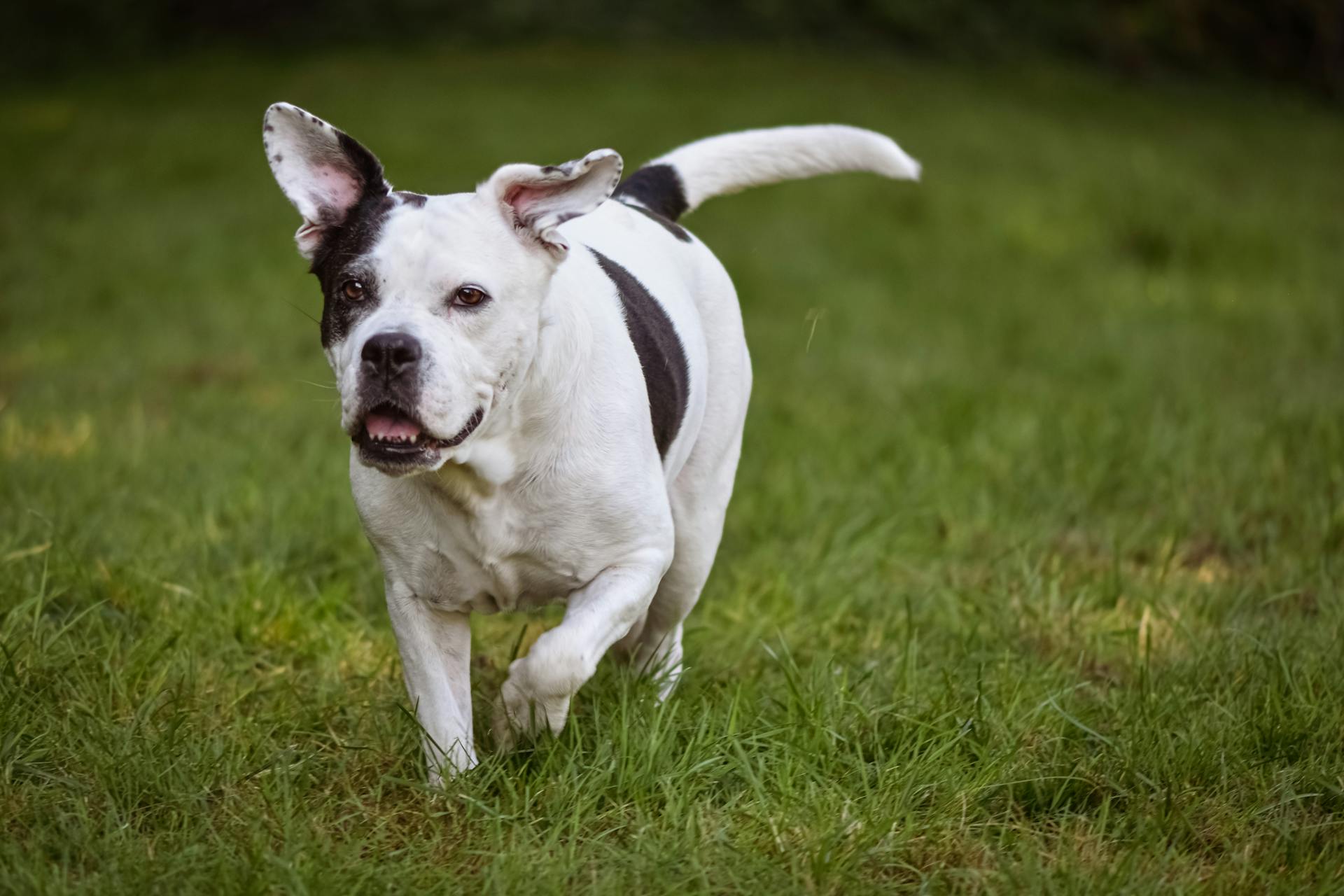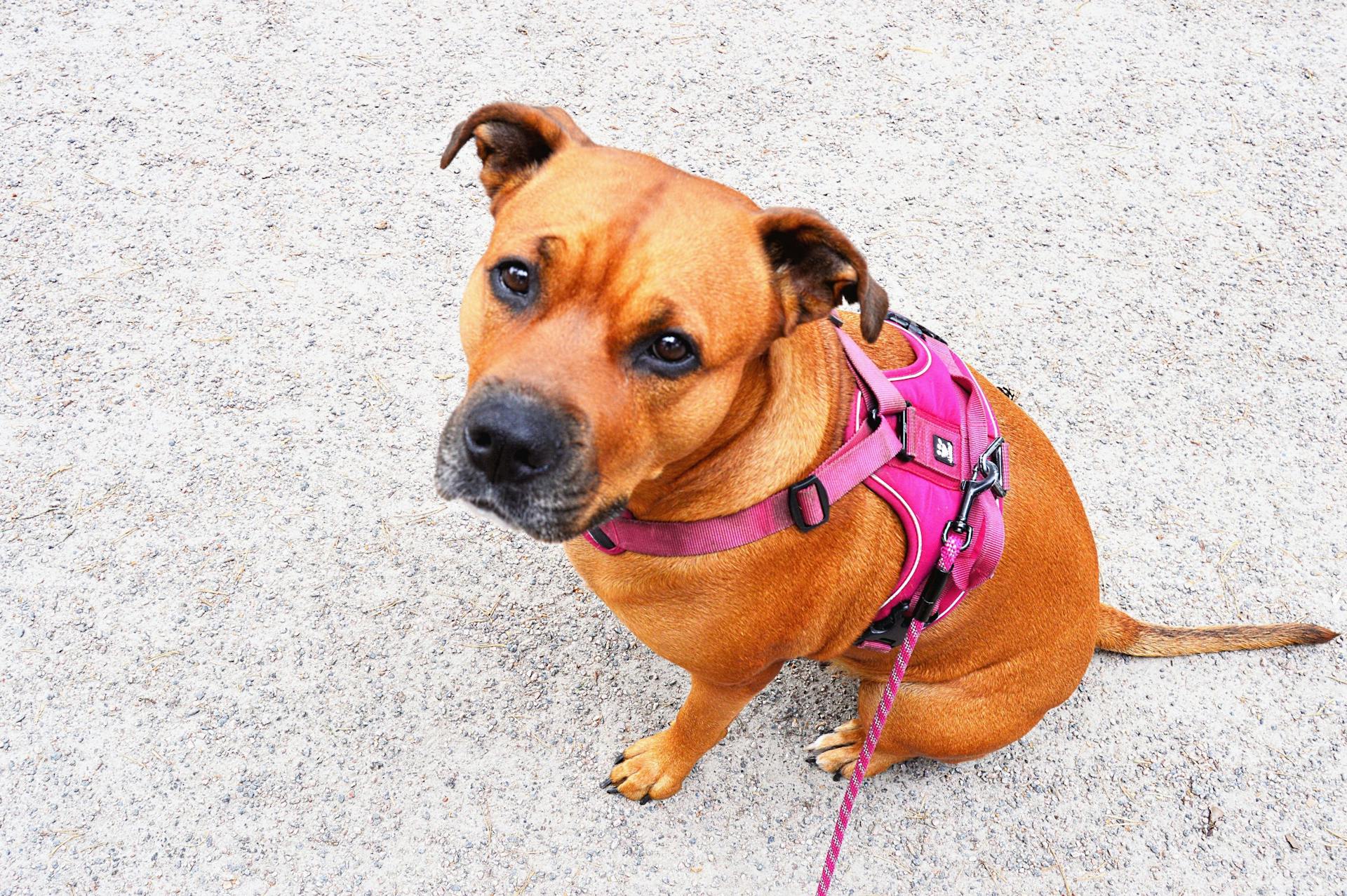
Training a Bull Terrier requires patience and consistency, as they can be strong-willed and stubborn at times.
The Bull Terrier is a breed that was originally developed for dog fighting, which has led to their natural instinct to be bold and fearless.
They thrive on structure and clear boundaries, so it's essential to establish a routine and set clear expectations from the start.
With positive reinforcement techniques, such as clicker training and reward-based learning, you can teach your Bull Terrier new behaviors and reinforce good habits.
A well-trained Bull Terrier is a joy to be around, and with the right approach, you can develop a strong and loving bond with your dog.
Training and Behavior
Training and behavior are crucial aspects of bull terrier training. Independent thinking and stubbornness can lead to challenging training sessions, but establishing clear leadership and using positive reinforcement techniques can help.
Bull terriers may exhibit aggression or dominant tendencies, so early socialization and ongoing training are essential to manage their behavior. This can help promote positive interactions with other dogs.
Teaching basic obedience commands like "Sit", "Stay", and "Come" is vital for effective communication and control over your bull terrier. These commands can help with impulse control and safety.
You might enjoy: Alaskan Malamute Behavior
Prey Drive
Bull Terriers have a high prey drive, making them more inclined to chase small animals. Proper training, supervision, and impulse control exercises are necessary to manage this behavior and ensure safety.
A strong prey drive can be a challenge to manage, especially if you have young children or other pets in the household.
Proper training is key to managing a Bull Terrier's prey drive, and this includes teaching basic obedience commands like "sit" and "stay".
Stubbornness
Stubbornness is a common challenge when training Bull Terriers. Independent thinking can lead to stubbornness, making it essential to establish clear leadership.
Bull Terriers are intelligent dogs, but their independent thinking can cause them to resist training. Positive reinforcement techniques can help motivate them.
It's crucial to use clear and consistent commands to avoid confusion. This will help your Bull Terrier understand what's expected of them.
Positive reinforcement techniques, such as treats and praise, can encourage good behavior. This is especially effective when combined with clear leadership and consistent training.
You might enjoy: When Is the Best Time to Breed a Female Dog
Aggression and Dominance
Aggression and dominance tendencies can be a challenge in some Bull Terriers. Early socialization is essential to manage their behavior effectively.
Some Bull Terriers may exhibit aggression or dominant tendencies, so it's crucial to provide them with proper training and socialization from an early age. Ongoing training is also necessary to promote positive interactions with other dogs.
Aggression and dominance can be managed with consistent training and socialization, but it requires patience and effort from the owner.
Basic Obedience Commands
Teaching your Bull Terrier basic obedience commands is essential for effective communication and control. These commands will help you build a strong bond with your dog and ensure their safety.
To start, teach your Bull Terrier to sit on command by holding a treat above their head and moving it backward. This will help them learn to lower into a sitting position naturally.
The "Sit" command should be practiced in various environments to reinforce the behavior. This will help your dog understand that the command is universal, not limited to one specific location.
Expand your knowledge: Can Shiba Inu Hit 1 Cent
The "Stay" command is crucial for teaching impulse control. Start by having your dog sit, then say "Stay" and take a step back. Reward them with a treat and praise if they remain in place.
Gradually increase the duration and distance of the "Stay" command over time. This will help your dog learn to stay in one place for longer periods and from farther away.
Teaching your Bull Terrier to come when called is vital for their safety. Begin in a controlled environment, say "Come" in an upbeat tone, and encourage them to come to you.
Related reading: Yorkshire Terrier in Heat
Crate
Crate training is a game-changer for Bull Terriers. It provides a safe and comfortable space for your dog while aiding in housebreaking. Introduce the crate gradually, making it a positive and inviting space with comfortable bedding and toys. Use positive reinforcement, such as treats and praise, to encourage your Bull Terrier to enter and stay in the crate.
Check this out: What Size Dog Crate for English Bulldog
Start with short intervals and gradually increase the duration of crate time as your Bull Terrier becomes comfortable. Establish a consistent schedule for letting your Bull Terrier out of the crate for bathroom breaks and playtime. This will help your dog learn to hold their bladder and bowels until it's time to go outside.
Avoid using the crate as a form of punishment, as this can create negative associations for your Bull Terrier. Your dog should associate the crate with positive experiences and safety.
For your interest: When Is Best to Breed a Dog
Attention
Getting your dog's attention is a crucial part of any training session. Top dog-handler teams all have one thing in common: they know how to get and keep their dog's attention.
To train your dog to focus, use commands like Catch and Watch. These commands are great for teaching your dog to pay attention.
Know your dog's preferences and prepare with multiple levels of bait. This means having something your dog likes pretty well, but also having something they're absolutely nuts about in reserve.
Catch your dog before distractions take over. This is especially important if you're training in a busy area with lots of other dogs and people.
Common Movement Patterns

As you practice movement patterns with your dog, it's essential to include a "Go Around" exercise, where you walk your dog once or multiple times around the ring, paying attention to where you're expected to stop.
Stopping at the right distance is crucial, aiming for about 5 feet in front of the judge so they can see your dog clearly.
If your dog has a great front or expression, stopping with them facing the judge will showcase these qualities.
In a triangle pattern, you'll move down to a corner, across the ring, and return on the diagonal to the judge, with left triangles being much more common than right triangles.
A "Down and Back" exercise involves moving directly away from the judge in a straight line and then returning, often on a mat or across the ring.
A different take: Bernese Mountain Dog Exercise
Frequently Asked Questions
Are Bull Terriers difficult?
Bull Terriers can be challenging to train and manage due to their strong prey drive and independent nature. Early training and consistent exercise are crucial to bringing out their best qualities.
Is a Bull Terrier a good house dog?
Bull Terriers can make great family pets with proper training and socialization, but they're best suited for experienced owners with a stable household. They require careful consideration and may not be the best fit for all families.
Are English Bull Terriers obedient?
English Bull Terriers can be challenging to train due to their slow learning pace, but with consistent and clear instructions, they can grasp concepts and become obedient. Consistent training is key to unlocking their potential.
How to calm a Bull Terrier down?
Provide your Bull Terrier with physical and mental stimulation through exercise, training, and interactive activities to calm them down and channel their energy constructively. Engage your Bull Terrier with chew toys, puzzle toys, and fun activities to distract and calm them.
Featured Images: pexels.com


